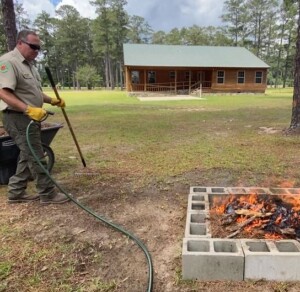By Frank Sorrells, Georgia Forestry Commission Protection Chief
The annual ban on outdoor burning in 54 Georgia counties (mostly in the northern part of the state) was recently lifted. Pending any local ordinances, outdoor burning of yard debris, leaves, and natural, hand-piled vegetation is again allowed until next summer (May 1, 2024). It is important to know that there also may be local ordinances issued by local county and/or city governments that have other requirements. Citizens must contact their local fire departments, code enforcement agencies, or emergency management officials to determine if other fire laws exist for their location.
In July of 2022, state law was changed (GA Code 12-6-90) to eliminate the need for a burn permit through the Georgia Forestry Commission for back yard burn piles. (Permits are still required for agricultural and land-clearing burns). The change supports Georgians’ right to burn on their property, yet sets certain requirements of burners, who are responsible for their fires and any damage an escaped fire may cause. The requirements specify safety measures that must be taken to decrease the chance of escape when someone is burning hand-piled vegetation.
There are common denominators that come up time and time again when wildfires are caused by someone who burns hand-piled vegetation and it “gets away.” Because these causes are determined so frequently, their preventive measures were written law in 2022.
 The Georgia Forestry Commission helps burners remember the five required safety procedures with an easy to learn formula. Before lighting a match, “Take 5,” and remember the five-pronged “Safety Star.”
The Georgia Forestry Commission helps burners remember the five required safety procedures with an easy to learn formula. Before lighting a match, “Take 5,” and remember the five-pronged “Safety Star.”
The first two prongs are “S” and they stand for SPACE.” There must be 25 feet of SPACE between the location of the burning and any woodlands, forestland, and/or open field that contains brush, grass, or other flammable material. This separates the burning from the surrounding vegetation, which is not intended to burn, and allows the burner a buffer around their fire to control it before it escapes.
There must also be 50 feet of SPACE between the burn pile and any structure, including outbuildings, sheds, barns, and homes. This separates the burning from buildings which may also catch on fire if the burning escapes or an airborne ember drifts away.
“T” stands for TIME. Burning must take place between the official sunrise and sunset times for the location where the burning is taking place. Residual smoke from a burn settles after dark and throughout the remainder of the evening and early morning hours, creating concerns for smoke-sensitive areas such as residential zones and neighborhoods. Many complaints are received when the smoke settles. It also may reduce visibility on roads for the traveling public and cause motor vehicle accidents and injuries. Burning during set daytime hours reduces this risk.
“A” is for ATTENDANCE. Person responsible shall attend to the burning at all times until completely extinguished and there is no risk for the burning to escape control. This ensures the person responsible is tending to their fire at all times and ready to take action if their fire starts to become uncontrollable and to completely put it out before they leave. In many instances, wildfires occur the next day, or even several days later,
because the fire was not completely extinguished and the fire rekindled. Pers on responsible shall be liable for any resulting damage to adjacent properties. This clarifies that the person who is burning is responsible and accountable for damages caused by their fire.
on responsible shall be liable for any resulting damage to adjacent properties. This clarifies that the person who is burning is responsible and accountable for damages caused by their fire.
“R” is for REASONABLE PRECAUTIONS. Person responsible shall take necessary precautions to prevent escape or spread from the original location; This ensures that the person responsible has considered the local weather for the day, including wind speed and direction, how long it has been since significant rainfall was received at the location, and the relative humidity. No one should burn when: the winds are, or will become, elevated and gusty and if the wind direction blows the fire and/or smoke toward other flammable vegetation and woodlands, or toward any structure; it’s been several days since significant rain has occurred; and the relative humidity is, or will become, low. In addition, the person responsible should have a cleared area down to mineral soil around the burn location or have a nonflammable barrier around their fire that prevents it from creeping out and escaping. It is prudent to have a pressurized water source ready and that the water can reach all areas around the burn location to extinguish the fire if it escapes.
Prior to the change in law, the GFC annually responded to 571 wildfires caused by escaped yard debris and other types of hand-piled vegetation. Since the implementation of the changes, there has been a modest reduction in the number of wildfires caused by someone burning their yard debris and hand-piled vegetation.
Since the change occurred, we have responded to 518 wildfires averaged over the last two years, or about a nine percent reduction. We recognize that there has not been a high reduction in the number of wildfires, however, we also know that many citizens are not yet familiar with and complying to the requirements. Continued public outreach by the GFC aims to inform the public of these conditions.
In FY22 and FY23 the GFC issued 929 Unlawful Burn Notices to individuals who weren’t in compliance with the requirement of GA Code 12-6-90. Most of these were for their failure to follow the legal requirements to burn yard debris, leaves, and other types of hand-piled natural vegetation.
The GFC is always ready to help Georgians understand their right to burn. More information can be found at GaTrees.org.
